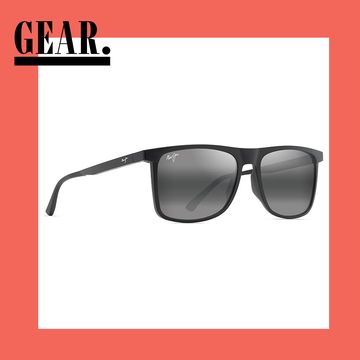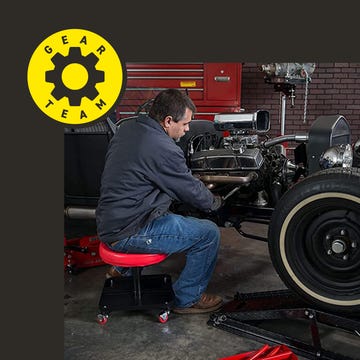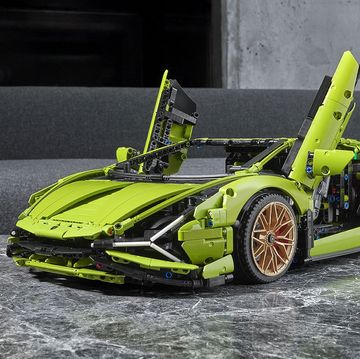We were recently invited to experience some gear we've been looking forward to for months—and what could be the most anticipated motorcycle helmet ever produced—the Sully AR-1. Skully is an augmented reality helmet that uses a built-in rear-view camera to provide a 180-degree view of what's behind the rider, which is projected on a heads-up display (HUD) in front of the rider to radically enhance situational awareness.
Now, we didn't get a chance to test the $50,000 prototype helmet on the street while riding a motorcycle—that, Skully CEO Marcus Weller says, will come later. Our first experience with the tech was limited to an hour or so inside a hotel conference room.
How was it? Impressive. Slide on the Skully and the first thing you'll notice is how well balanced it is.
"We looked at the helmet platform as a whole and said: If we're going to put technology back here, what could we put in this area (up front) to counter balance that weight?" Weller says. The answer is that the small cylindrical battery pack is located at the back of the helmet and the electronics to run the HUD are positioned in the front of the helmet.
Weller says the helmet weighs about as much as a conventional midrange-price helmet. The AR-1 is certainly comfy too. And part of that comes from the wonderfully soft padding derived from NASA space suits. He explained that this velvety interior fabric stays about a degree cooler than your skin and reduces perspiration by 70 percent.
RELATED: Ride-tested - Warm-weather motorcycle gear
The HUD unit is a small square about the size of your thumbnail that sits at cheekbone level when you're wearing the helmet. But because it's so close, it's easy to see. If you extend your arm out in front of you and look at your hand, that's about the size of the image as it appears in your field of vision. Weller says that his team tested one version with an image about 35 percent larger than this one, but decided it was too distracting.
"That was a surprise for us," he says. "We thought bigger would be better but ultimately, when your on the road that larger size begins to compete with the riders vision."
In my experience wearing the helmet, the display is small enough that it really disappears into the periphery until you need it. Then, when you quickly glance down and to the right, you see a clear color video feed of what's behind you. It's wild. It feels like you're wearing spy tech. Weller says the optics are designed for infinite focus, so you can look at something far away and then look back to the HUD, and your eye will adjust quickly.
Skully is still playing around with the HUD setup in this prototype. On the production version, all the safety-related information (the video feed) will remain unobstructed on the larger, bottom portion of the screen, while information such as navigation and speed will appear along a thin top banner. "We'd like to provide enough information in that banner to negate the need for a full screen navigation," Weller says.
RELATED: The Yamaha FZ-07 isn't a niche product, it's just a great motorcycle
As seamless as the experience appears to be, it would probably take some time for a rider to feel comfortable using this tech on the road. "Some have called our helmet the equivalent of Google Glass for motorcycles," says Skully creative lead Robert Gomez. "But we've been very careful to limit the amount of information that gets displayed." So don't expect an Iron Man helmet experience when you wear a Skully. "We're not just throwing your computer or phone screen up on the HUD," Weller says. "We have to filter that information so it doesn't effect your reaction time and how much you can process."
The production helmet will come with the rear view camera, the ability to stream music, a turn-by-turn navigation system as well as a companion app to provide speed and maybe even transmission gear position through your bike's ECU. But more will come—the helmet is designed to receive software updates and upgrades through the web so early adopters won't miss out on cool new features still in development.
New hardware tweaks are coming, too. Weller plans to add LED brake lighting to the back of the helmet to make the rider more visible. He also would like to add a camera-based blind spot detection system.
For fun, he says, Skully is developing a front-facing camera that would let riders stream a video feed of their ride to friends. And there's even a plan for a small wind turbine integrated into the shell that will charge the battery as you ride. The fan could spin the opposite direction and cool you down guided by an ambient temperature sensor. Smart.
"The features we have planned for subsequent versions of this helmet will blow your mind," he promises. We shall see: Skully says it will begin taking orders at some point before the end of September. And helmets will ship in early 2015. We can't wait to ride with one.
RELATED: You should build your own retro cafe racer

Ben is a lifelong enthusiast of anything with wheels. He has been contributing to Popular Mechanics for nearly 20 years and lives in Venice with an eclectic collection of vintage pickup trucks, muscle cars, and motorcycles scattered in various garages around SoCal.














